Étiquette : Benjamin Franklin
Hippolyte Carnot, father of modern republican education
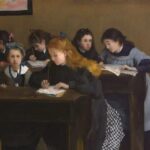

Table of contents
- Introduction
- In the storm
- From charity to universal schooling
- Malebranche and the Oratorians
- The Revolution of the Mind
- The Committee of Public Instruction (1791)
- Condorcet and the « American Party
- The « Condorcet » Plan
- The battle under the Convention (1792-1795)
- Lazare Carnot under Les Cent-Jours (The Hundred Days)
- Carrying on the torch
- Lazare Carnot’s exile
- Hippolyte with Abbé Grégoire
- Like Schiller, patriot and citizen of the world
- The Revolution of 1830
- Minister of Public Instruction under the Second Republic
- Hippolyte’s Carnot’s reforms
A. Nursery school
B. Primary school
C. Explanatory memorandum to the School Act of June 1848
D. Teachers to enlighten the rural world
E. Secondary education
F. High Commission for Scientific and Literary Studies
G. A School of Administration
H. Lifelong education for all
I. People’s libraries
J. Fine arts, hygiene and gymnastics on the program
K. Citizen Concord - Conclusion
- Appendix: works by Hippolyte Carnot
- Short list of books and articles consulted.
« The tree you are planting is as young as the Republic itself (…) It will spread its branches over you, just as the Republic will spread over France the benefits of Popular Instruction.
« Hippolyte Carnot, Memorial (1848), dossier 13.

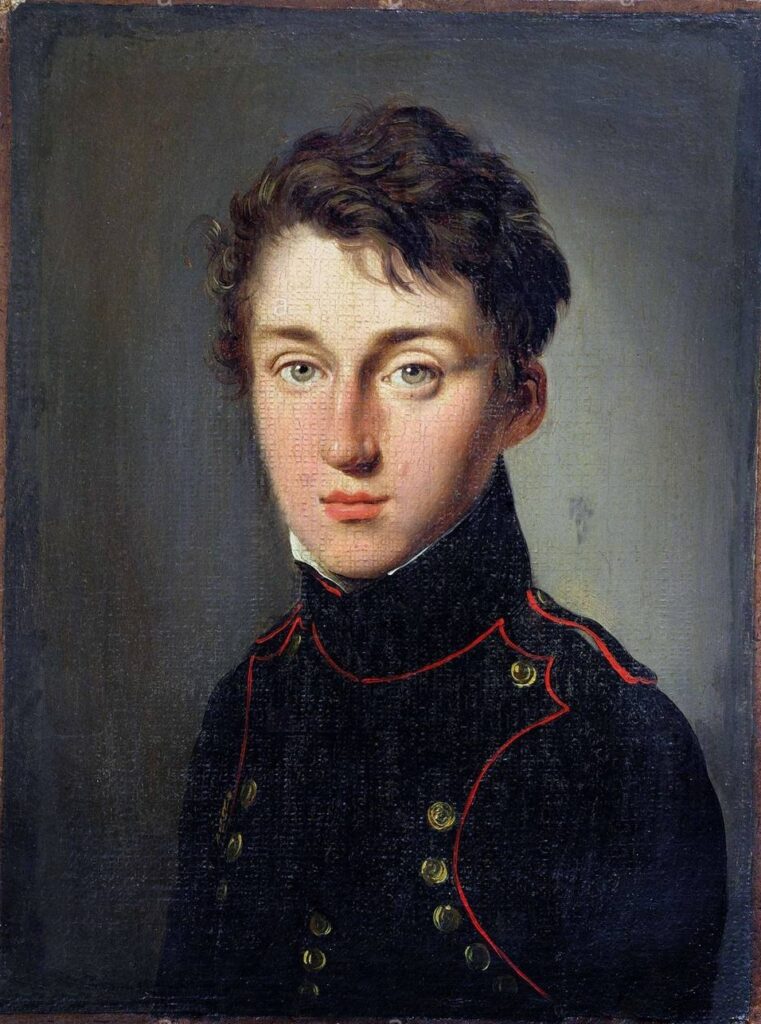

1. Introduction
Hippolyte Carnot (1801-1888) had neither the glory of his father Lazare Carnot (1753-1823), the « Organizer of Victory » of Year II, nor the renown of his brother, the inventor of thermodynamics Léonard Sadi Carnot (1796-1832), nor the tragic fate of his son, François Sadi Carnot (1837-1887), President of the Republic assassinated by an anarchist in Lyon.
History retains almost exclusively his magnificent « Memories on Lazare Carnot by his son », in which he recounts the actions, ideas and life of his father, the « great Carnot », scientific mind, poet, fervent republican and Minister of War.
Hippolyte remains little-known, despite the fact that his long life (87 years), slightly longer than Victor Hugo‘s (83 years), spans almost an entire century (1801-1888), and that his work and influence are considerable.
As is amply demonstrated by « Hippolyte Carnot et le ministère de l’Instruction publique de la IIe République » (PUF, 1948), written by his son, the physician Paul Carnot (1867-1957), he was much more than a mere observer or commentator on events.
2. In the storm
The 19th century was a period of profound change. The flame of hope kindled by the American and French Revolutions, the ideal of liberty, fraternity and emancipation of individuals, peoples and sovereign states alike, proved unquenchable, and was affirmed and extended throughout the 19th century. The long march towards a new paradigm was fraught with pitfalls. Changes took place slowly, against a backdrop of brutal crises and violent ruptures.

During his lifetime, Hippolyte Carnot (1801-1888) was directly or indirectly involved in :
Two Empires:
1803-1814: First Empire under Napoleon Bonaparte
1852-1870: Second Empire under Napoléon III
Three Monarchies:
1814-1815: First Restoration under Louis XVIII
1815-1830: Second Restoration under Charles X
1830-1848: July Monarchy under Louis-Philippe, Duc d’Orléans.
Two Republics:
1848-1852: Second Republic
1870: Third Republic
Three Revolutions expressing popular republican fervor:
1830 (Trois Glorieuses) ;
1848 (uprisings) ;
1871 (Commune).
In an ever-changing environment, through revolutions, coups d’état, monarchies, empires or republics, wars and trials, the man who was (too) briefly Minister of Public Instruction in 1848, a friend of Victor Hugo and Jules Ferry, Hippolyte was a nation builder and an inspiration.
Philosopher and journalist, memoirist and minister, Freemason and believer, political exile and member of parliament, senator and member of the Académie, he took part in all the battles for public and private freedoms, laid the foundations for teacher training and free, compulsory schooling, including kindergarten, created the forerunner of the ENA and defended the most advanced causes (schooling for girls, universal suffrage, the fight against slavery and the abolition of the death penalty).
Rémi Dalisson, in a fascinating and richly documented biography entitled « Hippolyte Carnot 1801-1888. La liberté, l’école et la République », published by the French CNRS in 2011, with supporting evidence, points out that « the vulgate of Jules Ferry as the inventor of the republican and secular school has been widely debunked ».

Given that Hippolyte‘s name, let alone his work, is nowhere to be found on the Ministry’s website, the author laments that « few people, including those at the Ministry of Education, pay tribute to the role and personality of Hippolyte Carnot« .
The anthologies of founding texts and speeches of the republican school, which have proliferated in recent years, systematically forget him.
« It is therefore an injustice and an oversight that we are repairing by tracing the life and work of Hippolyte Carnot, which go far beyond his educational projects and achievements. Through his stature, his training, his career, his ideas, his writings and his battles, this man of many talents will enable us to retrace the history of the construction of the school and therefore of society in the 19th century (…) And as this question refers to the political, social, even economic and cultural question of the nation, and as the minister was involved in all the philosophical battles of his century (…) it is largely the history of a century that will be evoked (…) ».
The full text of this magnificent biography is available free of charge on the Internet, and we have drawn heavily on it to write this text.
3. From charity to universal schooling

In order to fully appreciate the fundamental contribution of Lazare Carnot‘s ideas, and of their initial implementation by his son Hippolyte, a brief history of schooling in our country is in order.
Educating a handful of more or less talented children? We knew how to do it, especially since the tasty advice of the great Renaissance pedagogues (Vittorino da Feltre, Alexandre Hegius, Erasmus of Rotterdam, Juan Luis Vivès, Comenius, etc.). But organizing compulsory, secular and free education for an entire nation, boys and girls alike, remained an enormous challenge.
And as the following chronology shows, the road to universal schooling was strewn with many pitfalls.
In France, from the 16th century onwards, the royal state entrusted the Catholic Church (Jesuits, Oratorians and Brothers of the Christian Schools) with the task of educating state officials and the children of the nobility: only wealthy families could afford to pay a tutor for their own children, while the others, often described as « not suited to study », remained essentially illiterate.

In the 17th century, holy men, moved by the great misery of the children of the people, founded teaching orders to take in orphans and abandoned children free of charge. Their teaching was primarily religious, but they also provided them with food, basic education and basic writing and arithmetic skills. In the 18th century, women’s congregations took in poor girls in the same way.
Whatever his real motives, in 1698, following the revocation of the Edict of Nantes in 1685, Louis XIV ordered every village community or parish to open a school, whose teacher had to be a Catholic priest. This was the first time the state considered providing education for rural children.
Literacy figures at the end of the Ancien Régime show the scope and limits of the work accomplished. At that time, an estimated 37% of French people were literate enough to sign their marriage certificate, compared with 21% a century earlier. Female education progressed slowly, with around a quarter of women literate, many of them only in very basic terms. There were major disparities between town and country.
4. Malebranche and the Oratorians

Among the congregations, the Oratorians have been the exception since 1660, under the influence of the philosopher and theologian Nicolas Malebranche (1638-1715), who became its director. Breaking away from the Aristotelianism of the Jesuits and the dualism advocated by René Descartes, Malebranche, who had become an honorary member of the Académie des Sciences, was to be won over to the optimistic vision of the great German scientist Wilhelm Gottfried Leibniz through a sustained exchange of letters. Reconciling science and faith, on the metaphysical level his god is a wise and reasonable God, always respecting his essence and the laws of order he generates. His perfection lies above all in his function as legislator, identified with wisdom or reason, rather than arbitrary power.
Two examples demonstrate the excellence of their teaching: Gaspard Monge and Lazare Carnot, two great scientific minds and future co-founders of the Ecole Polytechnique. Convinced that the political, economic and industrial future of the Republic depended on it, they led the fight to ensure that the best possible education was available to all, not just the privileged few of whom they were a part.


The son of a Savoyard merchant, Gaspard Monge (1746-1818) studied at the Collège des Oratoriens in his native Beaune. From the age of 17, he taught mathematics at the Oratoriens de Lyon, then in 1771, mathematics and physics at the École de Génie established in Mézières. That same year, he came into contact with the physicist Jean Le Rond d’Alembert (1717-1783) and corresponded with the mathematician Nicolas de Condorcet (1743-1794), who encouraged him to submit four dissertations, one in each of the fields of mathematics he was studying at the time. It wasn’t long before his talents as a geometrician came to the fore: at the Ecole de Génie, he invented « Descriptive Geometry », which became part of the school’s curriculum and was essential to the industrial revolution just around the corner…
As for the future General Lazare Carnot (1753-1823), son of a Burgundian notary, after studying at the Oratoriens d’Autun (1762), he too entered the École du Génie de Mézières (1771), where he was taught by Gaspard Monge.
5. The Revolution of the Mind (1789)

In 1789, the Revolution turned the situation upside down. On February 13, 1790, all religious corporations and congregations were abolished by decree, and religious were ordered to swear an oath to the revolution. The all-powerful Church was totally challenged, and the few education that existed collapsed.

In a break with the Ancien Régime, the Constitution of 1791 asserted that « public instruction common to all citizens shall be created and organized. » A report and draft law were presented by Talleyrand (1754-1838) on September 10, 1791.
His Rapport sur l’Instruction publique, drafted in reality with contributions from some of the greatest scientists of the time (Condorcet, Lagrange, Monge, Lavoisier, La Harpe), represented a real break with the way education had been conceived under the Ancien Régime. It poses the question of public education in new terms, both in terms of principle (public education is presented as a political, social and moral necessity, and therefore as something the State must guarantee to its citizens) and in terms of form.
The plan encompassed the entire national education system, which was organized on four levels and whose establishments were distributed across the country according to administrative divisions. It laid the foundations for free education for all, including girls (separate schools and curricula), and specified that « the first elements of the French language, both spoken and written, will be taught ». In 1794, the jurist Bertrand Barère de Vieuzac (1755-1841) specified: « We will teach French to populations that speak Bas-Breton, German, Italian or Basque, in order to put them in a position to understand republican laws, and to attach them to the cause of the Revolution. » Due to lack of time, the bill was not passed.
In the bill, Talleyrand proposed the creation of an elementary school in each municipality. The Constituent Assembly had just established the territorial organization that is still in place today. The decree of December 14, 1789 had just created 44,000 municipalities (on the territory of the former « parishes »), which became « communes » in 1793. The law of December 22, 1789 created the départements, and the decree of February 26, 1790 set their number at 83.
6. The « Committee of Public Instruction » (1791)
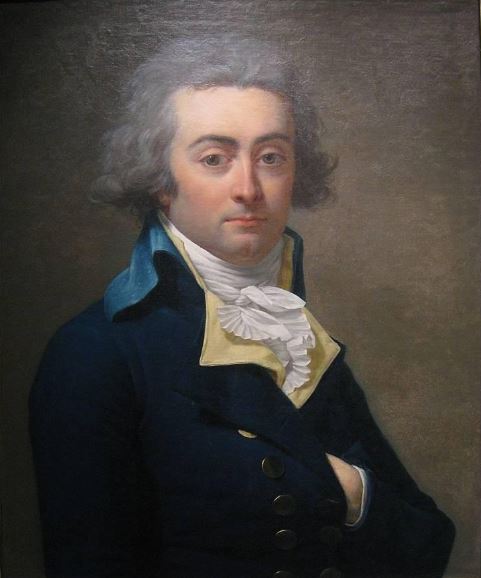
A month after Talleyrand’s report, on October 14, 1791, the National Legislative Assembly created its first « Committee of Public Instruction », of which the mathematician and philosopher Nicolas de Condorcet (1743-1794) was elected president and lawyer Emmanuel de Pastoret vice-president. The other members were future general Lazare Carnot, deputy Jean Debry, mathematician Louis Arbogast and politician Gilbert Romme.
Condorcet also presided over one of the three sections, dealing with the general organization of public education. On March 5, 1792, he was appointed rapporteur for the draft decree on the general organization of public education that the committee was to present to the Assembly.
Educated at the age of 11 at the Jesuit college in Reims, he was sent to the Collège de Navarre in Paris at the age of 15. Throughout his life, he retained painful memories of this primarily religious education, which he criticized for its brutality and humiliating methods. His indignation led him to imagine a totally different approach. In 1791, in La Bibliothèque de l’homme public (The Public Man’s Library), he published five memoirs on public education, constituting a veritable plan.
They formed the basis of the project he drafted for the Legislative Assembly, and were approved by the Committee of Public Instruction on April 18 and presented to the National Assembly on April 20 and 21, 1792.
7. Condorcet and the « American Party »

A hagiographer of the physiocrat Anne Robert Jacques Turgot (1727-1781), while criticizing the sectarianism of the « economists », Condorcet, in terms of economics, largely shared his Physiocratic worldview, notably the establishment of a tax on agricultural income alone, considered to be the nation’s sole source of wealth, with industry seen as a « sterile » category of the national economy (see my article dealing with Karl Marx’s errors).
For the Physiocrats, great defenders of the land rent that made them fat, the enemy to be fought was the centralized, dirigiste and mercantile state that Jean-Baptise Colbert, following in Sully’s footsteps, had begun to set up.
This did not prevent Condorcet, more courageous than many of his generation, from taking center stage in openly supporting the American Revolution in its fight for dignity and emancipation against the horrors of the British Empire: slavery, the death penalty, human and women’s rights.
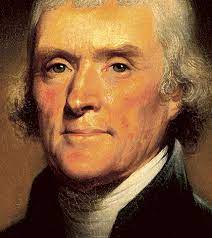

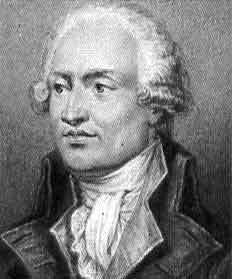
Although a friend of Voltaire, Condorcet wrote a vibrant eulogy of Benjamin Franklin. A friend of the influential English pamphleteer Thomas Paine, in 1786 he published « De l’influence de la Révolution d’Amérique sur l’Europe », dedicated to La Fayette. In this vibrant plea for democracy and freedom of the press, Condorcet considers that American Independence could serve as a model for a new political world. Along with Paine and du Chastellet, Condorcet contributed anonymously to an intermittent publication, Le Républicain, which promoted republican ideas. At the time, there were only a few states in the world known as republics (the Swiss cantons, Venice and the United Provinces, among others). Condorcet later had an argument with the second President of the United States, John Adams, whose encyclopedists scorned his proposal for a bicameral parliament.
Condorcet also made friends with the American president Thomas Jefferson, who promoted and published Condorcet’s writings in favor of the physiocrat Turgot in order to make them known in America. On July 31, 1788, Jefferson wrote to James Madison: « I am also sending you two little pamphlets by the Marquis de Condorcet, in which is the most judicious judgment I have ever seen on the great questions which are agitating this nation at this moment ». These were « Lettres d’un Citoyen des États-Unis à un Français et des Sentiments d’un Républicain ».

While in Paris, Jefferson frequented Mme de Condorcet’s cosmopolitan salon. Before returning to America, he received his closest friends one last time at his home, the Hôtel de Langeac: Condorcet, La Rochefoucauld, Lafayette and key organizer, Governor Morris.
After Jefferson’s return to America, Condorcet continued his dialogue with the American Secretary of State in Washington. On May 3, 1791, he sent him a copy of the report on the choice of a unit of measurement, presented by Borda, Lagrange, Laplace, Monge and himself to the Académie des Sciences on March 19, and subsequently submitted to the Assemblée nationale on the 26th. Indeed, it was a matter of common interest: on July 4, 1790, Jefferson had presented his Report on Weights and Measures to the American Congress, a copy of which he had sent to Condorcet. It was the same faith in progress that encouraged both men to support the idea of a universal, decimal system of measurement.
In a letter, Jefferson informed Condorcet of the work of a black American mathematician and astronomer, Benjamin Banneker, author of an almanac, of which he had sent him a copy. In his « Réflexions sur l’esclavage des nègres » (Reflections on Negro Slavery), Condorcet, though a staunch abolitionis, had expressed himself in favor of a gradual abolition of slavery, in the same way as Jefferson did in his « Notes on the State of Virginia ».
Jefferson oscillated in his positions, attributing the inferiority of blacks sometimes to natural causes, sometimes to the effects of slavery, while Condorcet – in agreement with Franklin – had always been convinced of the natural equality of all men.
In reality, the very man who became the third president of the United States owned over 600 slaves during his adult life. He freed two slaves during his lifetime, and five more were freed after his death, including two of his children from his relationship with his slave Sally Hemings. After his death, the remaining slaves were sold to pay off the debts of his estate.
Jefferson strongly opposed the « Federalists » like Alexander Hamilton, who promoted a strong federal state, Colbert-style economic dirigisme and mercantilism. Condorcet was to encourage Jefferson in his project of « agrarian democracy », the physiocratic vision of the great landowners that would become, until the arrival of Abraham Lincoln and his advisor Henry Carey, the ideology of the American Republican Party.
8. The « Condorcet » Plan
Progress of science and reason will lead to the happiness of societies and individuals, according to Condorcet. In Esquisse d’un tableau historique des progrès de l’esprit humain, he writes:
« Our hopes, concerning the future state of the human species, can be reduced to these three important points: the destruction of inequality between nations, the progress of equality within the same people; finally, the real perfection of man. »
Preferring « L’Instruction publique » to national education, he dreamed of an education totally independent of the State and free of dogmatism:
« Public authority cannot, even on any subject,
have the right to teach opinions as truths; it must not impose any belief. »
(Sur l’instruction publique, first memoir, 1791).
Outlining secular principles, for Condorcet, « the principles of morality taught in schools and institutes will be those which, founded on our natural feelings and on reason, belong equally to all men. »
At the National Assembly, he received massive applause when he declared :
« In these schools, the primary truths of social science will precede their applications. Neither the French Constitution nor even the Declaration of Rights will be presented to any class of citizens as tables descended from heaven, to be worshipped and believed. Their enthusiasm will not be based on the prejudices and habits of childhood; and they will be told: ‘This Declaration of Rights, which teaches you both what you owe to society and what you are entitled to demand of it, this Constitution which you must uphold at the expense of your life, are but the development of those simple principles, dictated by nature and reason, whose eternal truth you learned to recognize in your early years.
This Bill of Rights, which teaches you both what you owe to society and what you have the right to demand of it, this Constitution, which you must uphold at the cost of your life, is but the development of those simple principles, dictated by nature and reason, whose eternal truth you learned to recognize in your early years. As long as there are men who do not obey their reason alone, who receive their opinions from a foreign opinion, in vain will all chains have been broken, in vain will these command opinions be useful truths; the human race will no less remain divided into two classes, that of men who reason and that of men who believe, that of masters and that of slaves.' »
For those standing behind the Condorcet plan, the aim was to ensure the development of each individual’s abilities, and to strive for the perfection of humanity. His project proposed the creation of 5 categories of establishments:
- elementary school for civic and practical education ;
- secondary schools, with a focus on mathematics and science;
- institutions, providing training for primary and secondary school teachers in each département, and general education for pupils;
- lycées, training teachers and those « destined for professions in which great success can only be achieved through in-depth study of one or more sciences »;
- the Société nationale des sciences et des arts, whose mission was to manage schools, enrich cultural heritage and disseminate discoveries.
The plan was also characterized by the equality of ages and sexes in education, universal and free elementary education, and the freedom to open schools. Last but not least, religion was to be confined to the private sphere.
The project did not forget « the people », as weekly and monthly lectures for adults were intended to « continue education throughout life », an ambition taken up by Abbé Grégoire and Hippolyte Carnot.
As his son Paul Carnot recounts:
« In its short existence, the Constituent Assembly had only been able to pass on Talleyrand’s famous report to the Convention. After the no less famous reports by Condorcet and Lakanal, and the discussions of its Education Committee (almost as active as the Public Safety Committee), the Convention proclaimed the principles of compulsory, free and secular primary education, which are still ours today. The Declaration of the Rights of Man (art. XXII) proclaimed, with Robespierre, ‘Instruction is the need of all; society must favor, with all its power, the progress of public reason and put Instruction within the reach of all citizens’. »
Rarely were all parties in agreement on these points. The Girondins (Condorcet, Ducos) said, along with François Xavier Lanthenas (1754-1799), that « instruction is the State’s first debt to its citizens. »
On the subject of free education, Georges Danton said: « No one has the right not to educate his children. There is no real expense where there is a good use for the public interest. After bread, education is the first need of the people.
But the program of public education leading to the perfectibility of mankind thanks to reason, had not the chance to become a priority, as King Louis XVI, at the suggestion of General Dumouriez, went to the National Assembly to propose declaring war on Austria… Added to that, money for education wasn’t available.
Condorcet had to interrupt the lecture of his project. At the end of the afternoon of April 20, 1792, the Assembly adopted the declaration of war against the King of Bohemia and Hungary, unanimously minus seven votes. The following day, Condorcet completed the reading of his project. The Assembly decreed that the report be printed, but postponed discussion of it.
On May 24, Romme, on behalf of the Committee of Public Instruction, requested in vain that discussion of the report be placed on the agenda. Condorcet’s project, like Talleyrand’s report, did not have time to be debated, and was not adopted.
9. The battle under the « Convention » (1792-1795)

The protagonists of Year I (under the Convention) were hardly more decisive. A new Committee of Public Instruction was set up. It included Abbé Henri Grégoire, abolitionist and close friend of Lazare Carnot and later of his son Hippolyte, and Joseph Lakanal (1762-1845).
On December 12, 1792, Marie-Joseph de Chénier (1764-1811) read Lanthénas’s proposals, which echoed the ideas of Talleyrand and Condorcet. The discussions were fruitless, and the project was swept aside by Marat. Marat exclaimed that day:
« However brilliant the speeches we hear here on this subject may be, they must give way to more urgent interests. You are like a general who would amuse himself by planting and removing trees to feed starving soldiers. I ask that the assembly order the printing of these speeches, to attend to more important objects. »

The following year, Robespierre opted for a national education plan devised by Lepeltier de Saint-Fargeau (1760-1793). According to this plan, presented by Robespierre himself on July 13, 1793, education without a healthy dose of republican ideology would not suffice to regenerate the human race. It is therefore up to the State to inculcate a republican morality, by taking charge of the common education of children between the ages of 5 and 12.
On January 21, 1793, the King was beheaded. While Carnot, who only backed the decision to prevent any possible return to power of the Monarchy, Condorcet, who was opposed to the death penalty on principle, opposed it.
Debates on public education were delayed. It was not until the end of the year that compromise legislation on the organization of elementary school came into being, making education compulsory and free for all children aged six to eight, and establishing the freedom to all to open schools. The decree of December 19, 1793 stipulated that primary schools were the first level of instruction, teaching the knowledge strictly necessary for all citizens, and that those responsible for teaching in these schools would henceforth be called « instituteurs » (teachers). This decree was only partially implemented.
1794 saw a profusion of legislative texts on the subject including the decree of January 27, 1794 which imposed the use of the French language in all education.
On October 21, 1794, another decision organized the distribution of the first schools in the communes.
On October 30, at the instigation of Dominique Joseph Garat, Joseph Lakanal and the Comité d’Instruction Publique, the first « Ecole Normale » was created to train teachers. The law stipulated that « a teacher training college would be established in Paris, to which citizens from all parts of the Republic who were already educated in the useful sciences would be called, to learn the art of teaching under the most skilful teachers in all disciplines ». The school, planned for some 1,500 students, was set up in an amphitheatre at the Muséum national d’histoire naturelle, which was too small to accommodate the entire class. Although the school was soon closed, it nevertheless attracted a number of brilliant teachers, including the scientists Monge, Vandermonde, Daubenton and Berthollet.
On November 17, 1794, Lakanal had a law passed making education free, with the Republic providing salaries and housing for teachers, and authorizing the creation of private schools.
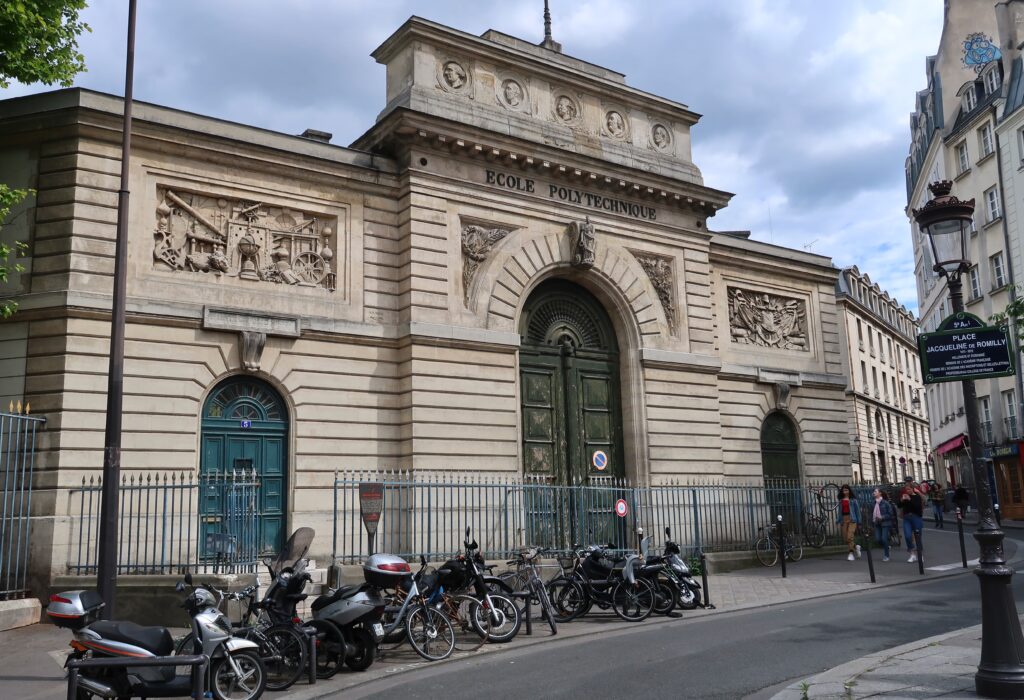
Also in 1794, Jacques-Élie Lamblardie, Gaspard Monge and Lazare Carnot, the institution’s founding fathers, were given the task of organizing a « Ecole centrale des travaux publics », renamed the « École Polytechnique » in 1795 by Claude Prieur de la Côte d’Or, not only to alleviate the shortage of engineers in post-Revolution France, but to create, by intensive training in projective geometry, a generation of scientific geniuses.
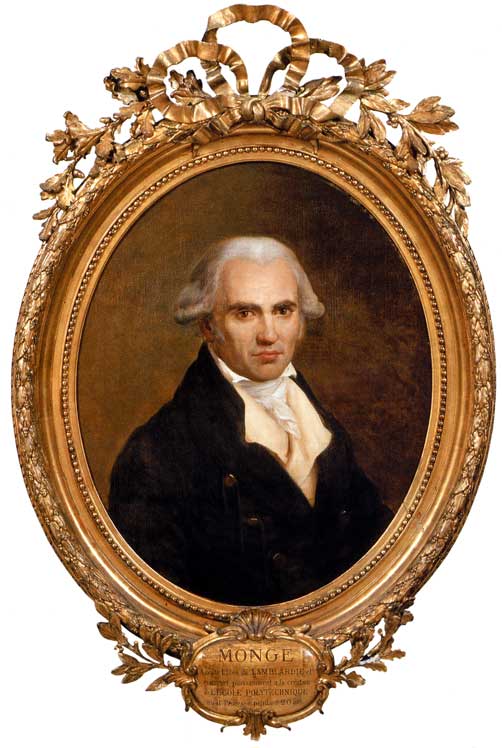


Unfortunately, in terms of universal schooling, the results in 1795 were disastrous: none of the decrees of 1794 had been implemented. Worse still, on October 25, 1795, a new law drafted by Pierre Daunou marked a step backwards: for lack of a budget, education was no longer free, teachers had to be paid by pupils (and their wealthy relatives), and the school curriculum was poor. This law remained in force until Napoleon’s texts on secondary and higher education in 1802. While it abandoned compulsory and free education, it did call for the creation of one elementary school per canton and secondary « central schools » in each département.
The new authorities set deadlines for municipalities to organize schools. They sent special envoys to see whether municipalities were taking the necessary steps to find and install a teacher.
In the towns and cities, the administration managed to recruit a certain number of candidate teachers, but in the countryside, the list often remained empty. In addition to the problem of recruitment, local authorities were faced with the problem of money, furniture, heating and books. Practising teachers complained about the shortage of pupils, as the republican school aroused mistrust. When the teacher ventured to replace the catechism and the Gospels with the Constitution and the Rights of Man, parents, encouraged by resistant priests, preferred to keep their children at home. The Comité d’Instruction Publique was inundated with questions, suggestions and requests.
On November 17, 1795, Lakanal had a new law passed by the Convention. Education remained free but not compulsory. It guaranteed a fixed salary and pension for teachers, and provided them with premises and housing. It authorized all citizens to set up private schools.
10. Lazare Carnot during the Cent-Jours (The Hundred Days)
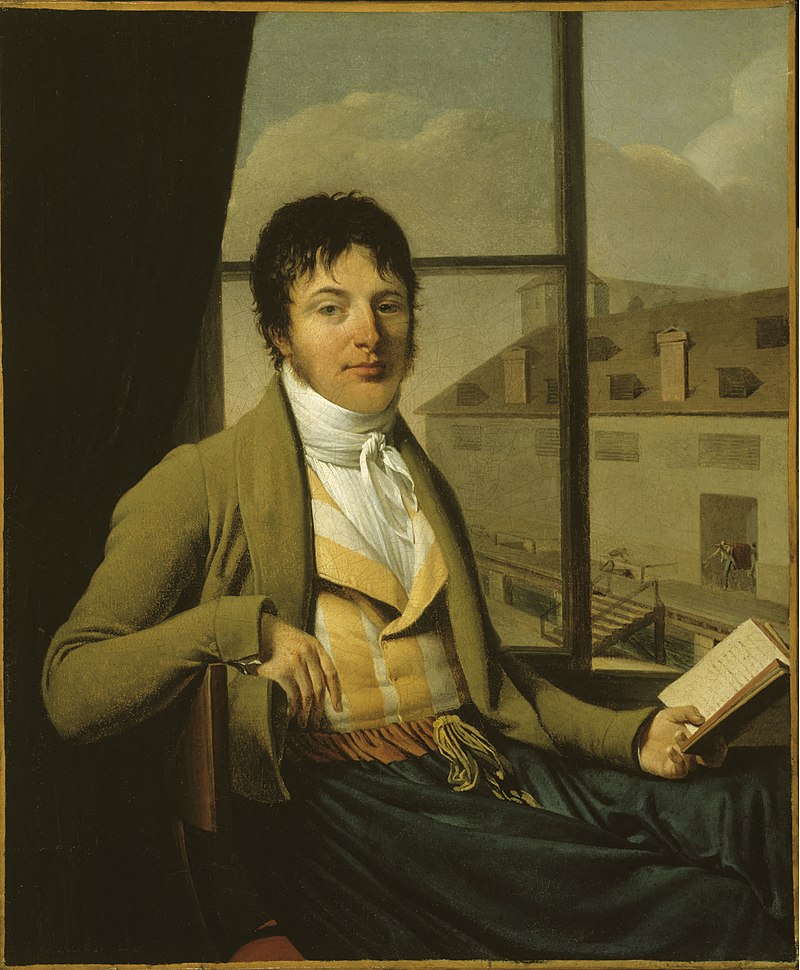
On November 9, 1799, Bonaparte fomented a coup d’état and established the Consulate regime. As First Consul, he signed the Concordat with Pope Pius VII on July 16, 1801, abolishing the 1795 law separating Church and State.
Seizing the opportunity of the moment, and above all seeking to respond to immediate needs, the Minister of the Interior, the republican chemist and industrialist Jean-Antoine Chaptal (1756-1832), submitted to Bonaparte a project for the organization of secondary education, entrusted in particular to the Oratorians of Tournon. In 1800, he presented his « Rapport et projet de loi sur l’instruction publique » (Report and draft law on public education).
Recalled by the First Consul, Lazare Carnot was given the War portfolio, which he held until the conclusion of the Peace of Amiens in 1802, after the battles of Marengo and Hohenlinden.
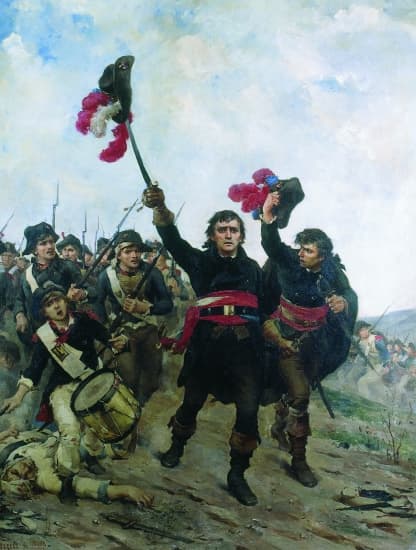
An early revolutionary, but also a moderate and republican, he voted against the Consulate for life, then was the only speaker to vote against the Empire on May 1, 1804.
From then on, deprived of all political influence, he refocused on the Académie des Sciences. In 1814, he was entrusted with the defense of Antwerp, a city of which he became mayor: he held on for a long time, and only agreed to hand over the city on the orders of Louis XVIII.
But a few months later, the Emperor returned to power for the Hundred Days, from March to June 1815. It was at this point that Lazare, who had finally been threatened with arrest to the point of hiding out on rue du Parc-Royal, was appointed Minister of the Interior on March 22, 1815. And as this ministry included Public Instruction in its remit, he was able to launch the educational project that was so close to his heart.


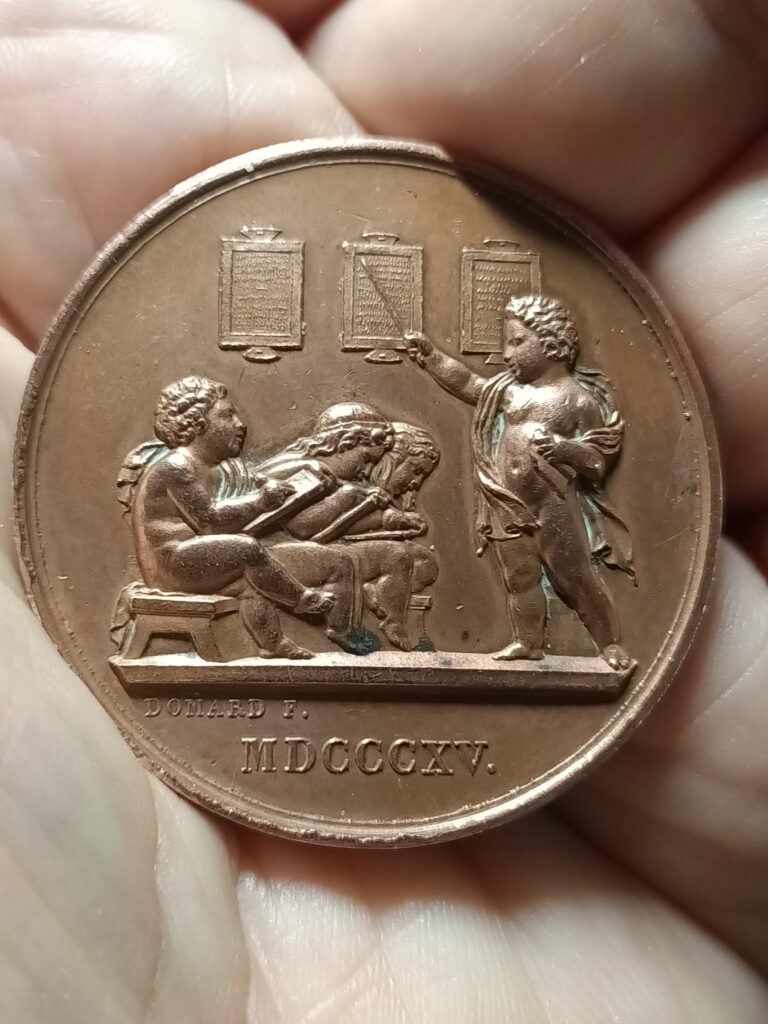
Three days after his installation at the Ministry, Lazare Carnot commissioned a study on education. It was inspired by the work of the « Société d’encouragement pour l’industrie nationale », headed by philanthropist Joseph Marie de Gérando, who had also been educated by the Oratorians in Lyon and was a proponent of Mutual Tuition.
Carnot and his faction then founded the « Société pour l’Instruction Elémentaire » (SIE) to promote this type of education. For Carnot and Grégoire, education and instruction should « elevate all individuals of the human species to the dignity of Man », educate as much as moralize, and spread love among men.

During the Hundred Days, Carnot had just enough time to prepare, in April 1815, a « comprehensive plan for popular education », followed by a decree and the creation of a Special Commission for Elementary Education, tasked with outlining prospects in this area, drawing inspiration from English and Dutch models.
Familiar with the « brigades » invented by Gaspard Monge at Polytechnique, where the best students supervised the others, Carnot was in favor of the system of mutual tuition in popular schools. For him, the issue was not alleviating the suffering of the poor or avoiding social chaos, but educating every citizen of the Republic, whatever his conditions, to have a functial Republic. After spreading to England and Switzerland, Carnot established mutual tuition in France. Convinced of the importance of music and linear drawing, he wanted pupils to be taught it.
With this in mind, he met several times with Alexandre-Étienne Choron (1771-1834), who had also been educated by the Oratorians, and brought together a number of children to perform several pieces learned in very few lessons. Carnot had also known the pedagogue Louis Bocquillon, known as Wilhem (1781-1832), for ten years. He also saw the possibility of introducing singing into schools, and together they visited the Mutual Tuition pilot project on rue Jean-de-Beauvais, which had opened in Paris to three hundred children. Starting from there, Wilhem created the mass musical movement known as « Orphéons ». (see article by Christine Bierre)
11. Hippolyte carries on the Torch
Lazare, a pupil of Gaspard Monde and a scientific mind of the highest order, had strong ideas about education that would shape the personalities of his sons, notably Hippolyte, the future Minister of Public Instruction in the Second Republic. For the two Carnots,
« all social institutions must aim at the physical, intellectual and moral improvement of the largest and poorest classes ».
More than « full heads », he aspired to turn his sons into « well-made heads », « to let us know the taste of good things rather than make us infallible about the meaning of words », in the words of his younger son. For Lazare, it was a matter of putting to the test in the family the educational principles he advocated for the nation.
Although he had little interest in « dead languages » and was more interested in living ones, Lazare introduced his children to Latin, which was once again a compulsory language in the imperial lycées created in May 1802. For the rest, while their father’s rich library introduced Sadi Carnot and his brother Hippolyte to the classics that were essential to the humanist culture on which secondary education was based, it also introduced them to other, more contemporary and innovative thinkers.
Among them, Hippolyte was interested in those who addressed educational issues, such as Rousseau, but also in more original philosophers like Saint-Simon (whose movement was attractive but became a cult after his lifetime), of whom Lazare Carnot said:
« Here is a man who is called extravagant, yet he has said more sensible things in his entire life than the wise men who scoff at him […]. But he is a very original, very bold mind whose ideas deserve the attention of philosophers and statesmen ». Evoking his father, Hippolyte would later say, « The lessons we received were all intended to make us, like the master who gave them, virtuous without effort, wise without system. »
Lazare Carnot sends Hippolyte to the Polytechnic Institution, 8 avenue de Neuilly. According to Dalisson,
« the young Carnot received a Spartan education where, while discipline did not exclude corporal punishment under the rule of ‘Inspecteurs généraux’, pedagogy was innovative. Pupils were divided into classes according to age, and teaching combined intellectual and physical education through programs that complemented their father’s education. Hippolyte thus perfected his reading, ancient and modern languages, literature, mathematics, physics and geometry, and acquired a taste for chronology, history, drawing, music, fencing and dance, proving himself an excellent student in every respect.«
12. Exile of Lazare Carnot
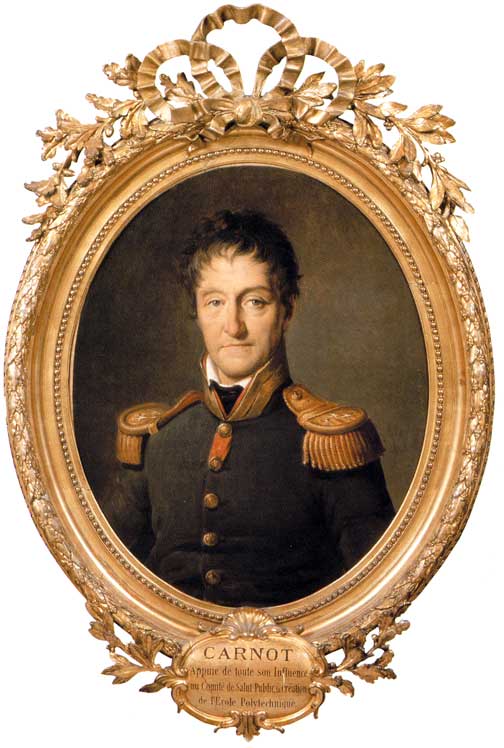
After Napoleon’s second abdication, Lazare Carnot joins the provisional government. Exiled at the time of the Restoration, he was banished as a regicide in 1816 and retired to Warsaw, then to Magdeburg, where he devoted the rest of his life to study and, above all, the education of his children.
Dalisson: « when he’s not at school, he (Hippolyte) serves as secretary to his father, who continues his education ». In Magdeburg, « one of Carnot’s consolations was to complete the education of his young son, whose studies he directed more especially towards historical questions and social economics ». So it was in Prussia that Hippolyte found his way, abandoning the « hard » sciences to devote himself to philosophy in general, and political and social philosophy in particular. There, education had a privileged status since Frederick II had made primary education compulsory in 1763, envisaged a form of free education (for poor families) and created gymnasiums for secondary education. Enough to inspire Carnot père and fils to imagine how France could catch up.
Better still, as Dalisson points out:
« Prussia remains a kingdom which, like France a few years earlier, carried out a « levée en masse » (mass recruitment) in 1813 to drive out the invader. The link between popular education and national sentiment, between education and the economy, between liberalism and national education, is an obvious one, and ties in with the Carnot family’s educational ideals. That’s why, at the [prussian] government’s request, Lazare set up an educational project to create a « vocational school » in this distant host country. With the help of Hippolyte, he set up a complete teaching system for agriculture and industry. Although we have no trace of the text, it undoubtedly influenced the young man as much for his Parisian and liberal years as for his future ministry ».
13. Hippolyte with Abbé Grégoire

Back in France, Hippolyte contacted his father’s old friends, notably Abbé Henri Grégoire. An emblematic figure in the fight for the emancipation of Jews and blacks, this « revolutionary bishop » called for the total abolition of privileges and advocated universal male suffrage.
In principle, Hippolyte approved. However, in practice, after observing the people’s infatuation with public executions, he discovers how easily a crowd can be led, even manipulated, by playing on irrationality, passion and impulses – all things that make the use of universal suffrage tricky, and can lead to dictatorship. He concludes that popular education must enlighten the people to bring them back to more fraternal and reasonable sentiments.
For Abbé Grégoire, as for Carnot père and fils, slavery must be abolished, nations must free themselves from Empires by recovering their sovereignty, and education must free citizens from ignorance, a set of subjects marvelously brought together in the iconography of the bas-reliefs on the base of the statue of Gutenberg in Strasbourg, a commemorative monument created by a friend of both Grégoire and Hippolyte, after Victor Hugo, the sculptor David d’Angers.
As a member of the Comité d’Instruction Publique, Henri Grégoire called for the generalization of the French language, as the Oratorians had done before him, and became the rapporteur for the abolition of the old academies and the creation of the Institut.
The opening of a whole series of « special schools », such as the Ecole polytechnique (1794) and the Institut des langues orientales (1795), the establishment of the Musée du Louvre (1793), the preliminary project for a Bibliothèque nationale (1790), the creation of the Bureau des Longitudes (1795), the introduction of new units of weights and measures, the metric and decimal systems, the extension of elementary schools to all communes and one of the jewels in the crown of this policy: the founding of the Conservatoire National des Arts et Métiers (1794), owed much of their success to the boundless energy of Abbé Grégoire.
The aim was to transmit technical knowledge to two types of audience. On the one hand, the « grandes écoles », aimed at the country’s new elites, provided high-level education to train scientists and engineers (École polytechnique, Ponts et chaussées, etc.) or the future teachers of the new public education system with the École normale (1794); on the other hand, schools designed for middle management in factories, good workers and workshop managers: this was the case of the écoles d’arts et métiers, heirs to the vocational school imagined in 1780 in Liancourt (60) by the Duc de la Rochefoucauld-Liancourt.
Grégoire also established several major institutions that still exist today, including, in addition to those already mentioned, the Natural History Museum (1793), the Royal Garden of Medicinal Plants (1793) and the Museum of French Monuments (1795).

Grégoire introduced the young Hippolyte to the Masonic lodge of which he was a member, Les Philadelphes. Inspired by Grégoire’s struggle, of which he would be the executor and about which he would publish a work towards the end of his life, Hippolyte, barely 23 years old, published « Gunima, an 18th-century African short story » (1824), a philosophical tale recounting the moral education of young Benjamin who, equipped with the principles of the Enlightenment, confronts his prejudices and the injustice of the slave and servitude regime of the so-called Hottentots of the Cape. Surprisingly modern, the story takes up the challenge of fraternity at a time when France was responding to Haiti’s demands for recognition.
True to the philosophy of Abbé Grégoire, he protested against the expulsion of Jews from Dresden, where they were forbidden to stay. Indignant, he tried to alert public opinion: since 1789, Jews have been French citizens like any others. He reaffirmed his faith in freedom of worship, which had enabled the emancipation of the Jews, and exclaimed:
« If we call a Jew someone who, from his mother’s womb, society condemns to the vilest slavery, who vegetates without rights in his homeland and serves as a breastplate for the insults of the rabble, to whom his actions deserve nothing (…) and who is relentlessly pursued by shame and contempt, then I am a Jew and always will be ».
14. Like Schiller, patriot and world citizen
From Dalisson‘s book:

« Carnot’s position is summed up at a celebration in homage to the French Revolution on March 19, 1838 in Paris. In the name of ‘holy equality, solidarity between all peoples and all races of men in a spirit of fraternity’, he toasted ‘the abolition of slavery, the cessation of this awful scandal of humanity’.
« From that day on, he collaborated regularly with Victor Schoelcher, a journalist, Freemason, close to the Saint-Simonians and member of the same societies as himself, whom he would meet again three years later in the government of the Republic, then in exile. Schoelcher had been confronted with slavery in Cuba as early as 1828 and also believed that their emancipation should be gradual, before changing his mind and becoming a supporter of immediate abolition.
« Freedom must also apply to peoples and therefore to nations, because ‘the principle of all sovereignty lies in the nation’. A son of 1789, educated during the struggles for national emancipation, a student steeped in Romanticism, passionate about the revolts of the fifties and thirties before being caught up in the « Spring of the Peoples », Carnot placed his trust in the freedom of nations: « Salvation will come from peoples uniting to overcome the common enemy, despotism. If liberated nations and peoples manage to get along and unite, they will even build ‘United Europe’.
« Throughout the century, he would support all national struggles, and hence national unity, against empires that oppressed minorities. For nationality ‘is the human right proclaimed in 1789, the right to group together according to one’s affinities of character, tradition, race and language, and is basically LIBERTY itself’.
Even after the 1870 war, he was convinced of a kind of « right of peoples to self-determination » in a Europe founded on the freedom of peoples.
In his writings on foreign policy, notes Dalisson, he regularly recalled Friedrich Schiller‘s maxim: « Man is created free, he is free, even if he is born in chains. (…) Do not tremble before the free man. This freedom of peoples and nations must even be based, horresco referens, on the necessary reconciliation between France and Germany, two neighboring peoples who have been separated by the vicissitudes of history, but who are « two friends who have been divided by long quarrels and who need to explain themselves ».
15. The 1830 Revolution

The Revolution of 1830, also known as the July Revolution or the « Three Glorious Days », took place in Paris on July 27-28-29, 1830. Parisians, at that time the foremost revolutianary citizenry, rose up against the reactionary policies of King Charles X’s government. One of them, was Hippolyte Carnot who had transgressed his legendary moderation, took a rifle and joined those on the barricades. The question immediately arose: « What should replace the king? » Many intended to restore the Republic.
On July 30, deputies and journalists in favor of the Duc d’Orléans put up posters recalling the « patriotic » past of the duke, a veteran of Valmy who claimed to be in line with the ideas of George Washington, and his commitment to the future: he would be « a citizen-king ».
Unconditionally, the representatives of the people (95 deputies present in Paris) proposed that the Duc d’Orléans be appointed Lieutenant-General of the kingdom.
On July 31, he accepted the position and went to Hôtel de Ville in Paris, the Republican headquarters. There, before a gathered crowd, he was embraced by La Fayette, both wrapped in the tricolor flag. Lafayette felt that a gradual transition to a republic could only be achieved through a constitutional monarchy. On August 9, the deputies amended the Charter of 1814 to become the constitutional « charter » of 1830, and the Duc d’Orléans was proclaimed « King of the French » under the name of Louis-Philippe I.

Hippolyte Carnot, always a moderate, believed in « representative democracy » and was elected three times as a deputy under the Monarchy of 1830. A spokesman of the opposition to the regime, he prepared for what was to come.
16. Minister of Public Instruction under the Second Republic (1848)

After an initial attempt to re-establish republican values, neutralized by Louis-Philippe’s « Coup d’état » in 1830, the uprisings of 1847-48 succeded in February 1848 with the formation, at Paris City Hall, of the « Provisional Government » led by several friends of Hippolyte Carnot, to establish the « Second Republic ».
The provisional government’s first measures were intended to break with the previous period. The death penalty was abolished in politics. Corporal punishment was abolished on March 12, and « contrainte par corps » (imprisonment for debt) on March 19.
On March 4, a commission was set up to resolve the problem of slavery in the French colonies. Under the aegis of the Minister of Colonies, the Republican astronomer François Arago, a close friend of Alexander von Humboldt, and whose Secretary of State was Victor Schoelcher, its work led to abolition on April 27.
In the political sphere, the changes were significant. Freedom of the press and of assembly were proclaimed on March 4. On March 5, the government instituted universal male suffrage, replacing the censal suffrage in force since 1815. In one fell swoop, the electorate rose from 250,000 to 9 million…
This democratic measure made the rural world, which accounted for three-quarters of the population, the master of political life for many decades to come. Elections for a Constituent Assembly are scheduled for April 9. Lafayette’s National Guard, previously reserved for notables and shopkeepers, was made accessible to all citizens.

The provisional government proposed appointing Hippolyte Carnot to the Ministry of War or the Interior; he declined the offer, but accepted the Ministry of Public Instruction (which Victor Hugo had just refused), to which was added the Ministry of Religious Affairs, which until then had been the responsibility of the Ministry of Justice. Carnot’s desire to see cults be part of public education was based not only on his lack of hostility to the Church, but also on his belief that a close alliance between the Republic and the lower clergy was the best guarantee of progress.
« I myself, » he wrote, « have religious sentiment too deeply engraved in my heart not to be and not to want those around me to be full of deference towards the ministers of all religions. » And again: « My constant efforts have been aimed at reattaching the lower clergy to the Republic. The minister of religion and the schoolmaster are, in my eyes, the columns on which the republican edifice must rest. »
17. Hippolyte Carnot’s reforms
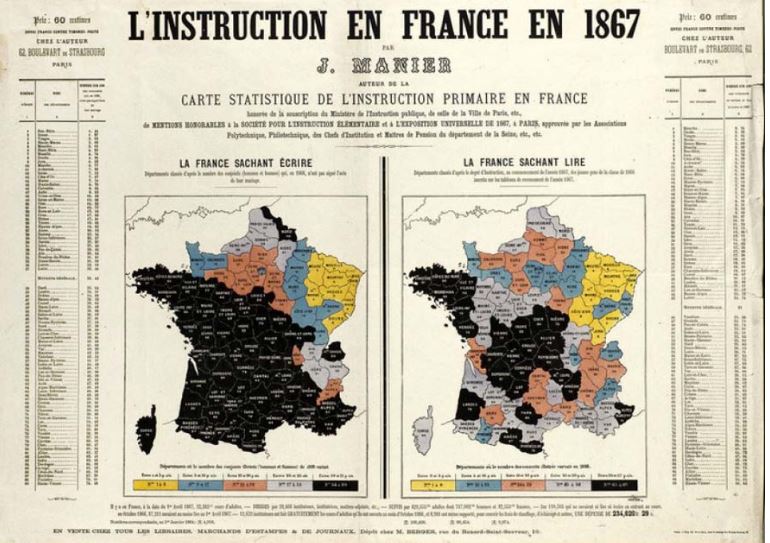
En s’appuyant sur le degré d’instruction des Français à l’âge du mariage, cette carte met en
évidence une grande disparité entre les régions. Ainsi, le taux d’alphabétisation des
habitants du nord et de l’est est-il nettement supérieur à celui des habitants du sud et de
l’ouest. La France alphabétisée est celle des grandes villes, des campagnes riches et des
populations denses.
During his very short ministry, armed with an overall vision that had been carefully thought through and prepared in advance, he announced, sometimes several times a week, republican reforms of all the major areas of education, from early childhood through to adults, including teacher training, senior civil servants and all citizens. Declaring in his preparatory notes that « it is important that the various levels of the education system integrate into each other, leading directly from one to the other ».
A. Nursery schools

For Carnot, « salles d’asile » were little more than charitable establishments run by nuns. Little was done to educate infants. Their name, reminiscent of misery and almsgiving, was replaced on April 28 by « nursery school ». « The child should find there the education he cannot receive from his mother, i.e. the care of the body, the language of feeling, and those little exercises intended, not yet to furnish the intelligence, but only to open it up ».
In the minds of Jean Reynaud (Under-Secretary of State for Public Instruction) and Carnot, the asylum was neither a school of instruction, nor a place of refuge for children deprived of their parents. At the same time, a « normal nursery school » was set up in Paris, for pupils aged between twenty and forty.
B. Primary schools
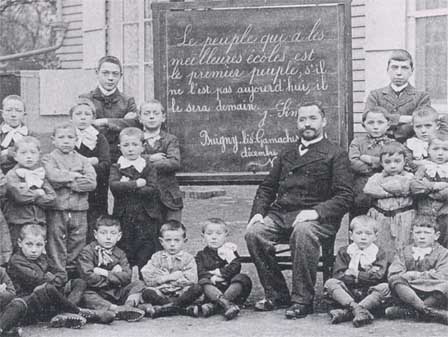
As early as February 27, in a circular to the rectors, Carnot expressed his intention to improve the condition of primary school teachers: « The condition of primary school teachers is one of the main objects of my solicitude…. It is to them that the foundations of national education are entrusted. It is not only important to raise their status through a fair increase in their salaries; the dignity of their function must be enhanced in every way…. Instead of sticking to the education they have received in elementary school, they must be constantly encouraged to improve it… There is nothing to prevent those who are capable of doing so from rising to the highest echelons of our hierarchy. Their lot in terms of advancement cannot be inferior to that of soldiers; their merit is also entitled to conquer ranks… However, to ensure that all are encouraged to emulate each other in such a glorious way, intermediate positions must be guaranteed. This will naturally be achieved by extending the teaching of mathematics, physics, natural history and agriculture to higher elementary school. In the name of the Republic, primary school teachers will therefore be invited to prepare themselves for the recruitment of staff for these schools. This is one of the complements to the establishment of primary teacher training colleges. It is in the interest of the Republic that the doors of the university hierarchy should be opened as wide as possible to these popular magistrates ».
On June 30, the Minister therefore tackled primary education. Before him, the ordinance of February 29, 1816 had marked a turning point. It established a cantonal committee to oversee schools and, in article 14, obliged communes, without giving them the means to do so, to « ensure that the children who live there receive primary education, and that indigent children receive it free of charge ». In short, primary education was left entirely to the communes, which in turn, for lack of premises and resources, called on religious congregations.
The minister therefore proposed « to raise the status of teachers by transforming them from commune officials into state officials », to emancipate them from local potentates, parents and clerics. For « it is certainly necessary that the teacher be accepted in his commune, but if he depends too much on it, he is not considered enough. It is therefore important that he cannot be capriciously dismissed ». With this in mind, he abolished the « certificate of morality », which had tied schoolteachers to the Church and, incidentally, to the government.
In addition to the compulsory schooling (for both sexes and for communes of at least 300 inhabitants) and total free education already mentioned, he wanted to complete the curricula to form a « uniform core curriculum (…) designed to review everything and serve to determine vocations », prefiguring the school of Jules Ferry and going further than just reading, writing and arithmetic.
In addition to national history and geography, several of Carnot’s favorite subjects, singing, natural history and linear drawing – three subjects designed to develop and educate – there are several specific features to be found in the new texts. The first, which would be taken up again thirty years later, is a kind of civic instruction that the Minister describes as « the duties and rights of man and citizen, the development of feelings of liberty, equality and fraternity (…), the basis of a civic education for the republican education of the country ».
Hippolyte had been elected to the Constituent Assembly on April 23, 1848. When, on May 10, 1848, the « Executive Commission » (May 9 – June 28, 1848) replaced the « Provisional Government » (February 24 – May 9, 1848), he retained his portfolio; but the executive, « in order to strengthen the revolutionary element », appointed Jean Reynaud (1806-1863), a former Saint-Simonian like himself, also elected as a representative, as Under-Secretary of State: I knew the real moderation of his principles, » Carnot wrote; « he knew the firmness of mine, and together we laughed at the role they were trying to assign him« . Edouard Charton (1807-1890), also a former Saint-Simonian and now a member of the Assembly, resigned as Secretary General, but continued his good offices without an official title.
Among Carnot’s actions in this second period of his ministry, we should mention the tabling, on June 3, of a draft decree opening a credit of 995,000 francs, intended to increase, for the second half of 1848, the salaries of those primary schoolteachers whose fixed and contingent salaries remained below six hundred francs; and a second credit, of 105,000 francs, intended to assist, during 1848, female communal schoolteachers whose fixed and contingent salaries remained below four hundred francs (the decree was voted on July 7).
C. Explanatory memorandum to the June 1848 School Act
The drafting of the primary education law continued in a small committee, charged with coordinating the work prepared by the High Commission. It was completed in the course of June, but the submission of the draft, delayed by events, could only take place on June 30, 1848. The explanatory statement reads as follows:
« Citoyens représentants, the difference between the Republic and the monarchy should nowhere be more profoundly demonstrated, in the field of public education, than in what concerns elementary school. Since the free will of the citizens must henceforth give the country its direction, it is on the proper preparation of this will that the future salvation and happiness of France will depend.
« The purpose of primary education is thus clearly defined. It is no longer simply a matter of equipping children with the notions of reading, writing and grammar; the State’s duty is to ensure that all children are brought up to be truly worthy of the great name of citizen that awaits them. Primary education must therefore include everything necessary for the development of the human being and the citizen, as the current conditions of French civilization allow us to conceive them. At the same time as introducing a greater body of knowledge into this teaching, it must also contribute more directly to moral education, and particularly to the consecration of the great principle of fraternity that we have inscribed on our flags, and which it is essential to make penetrate and live everywhere in people’s hearts if it is to be truly immortal.
« It is here, citizens, that primary education joins religious education, which is not the responsibility of the schools, but to which we sincerely appeal, to whatever religion it relates, because there is no more solid and general basis for the love of men than that which is deduced from the love of God.
« The establishment of the Republic, in giving primary education this new tendency, also required, as natural consequences, two important measures, which are to make this education free and compulsory.
« We want it to be compulsory, because no citizen can be exempted, without damage to the public interest, from an intellectual culture recognized as necessary for the proper exercise of his personal participation in sovereignty.
« We want it to be free, because we want it to be compulsory, and because there should be no distinction between the children of the rich and those of the poor in the schools of the Republic.
« We ask you to proclaim the freedom of education, i.e. the right of every citizen to communicate to others what he knows, and the right of the father of a family to have his children brought up by the teacher of his choice. We consider the declaration of this right as one of the legitimate and sincere applications of the word of liberty that our Republic has enthusiastically thrown into the world (…). (…) It even seemed to us that it would not be the least of the means of raising the standards of public schools to allow private schools to flourish, on condition that in this career of emulation, the former did not lack any favorable chance (…) In a word, citizens, the idea according to which we have directed ourselves has been the continual union of the principle of authority with that of liberty. (…) It is in this conciliation between two equally respectable principles that the whole spirit of the law we have the honor of submitting to you consists. »
Source : Hippolyte Carnot, Bulletin des lois, 1848
D. Schoolteachers called to enlighten the countryside

On March 5, a decree set April 9 as the date for convening the electoral assemblies for the appointment, by universal suffrage, of the « Constituent Assembly », which would sit from May 4 to 26. These were the first elections since 1792 to be held by universal male suffrage.
By decision of the Second Republic, the number of voters, which rose to 9,395,035, was multiplied by 40 !
However, as we have said, while Hippolyte Carnot was theoretically in favor of universal suffrage, with the vast majority of French people uneducated, the expression of the vote was likely to lead to disaster. No part of primary education, he writes, « has been more neglected under previous governments than the training of children as citizens ». As a result, many of the voters who have just been invested with the right to vote by the decree of the provisional government are not, especially in the countryside, sufficiently educated in the interests of public affairs.
To try and enlighten these voters about their rights and freedoms, Carnot appealed to schoolteachers:
« Encourage those around you who are capable of such a task to compose short manuals for your schoolteachers, with questions and answers, on the rights and duties of citizens. See to it that these books reach the teachers in your jurisdiction, and that they become in their hands the text of profitable lessons. This is what is going to be done in Paris before my eyes; imitate it. Let our 36,000 primary schoolteachers rise to my call and immediately become the repairers of public education for the rural population. May my voice reach even our last villages! I beg them to do their part in founding the Republic. It’s not a question of defending it against the danger of its borders, as it was in the days of our fathers; it’s a question of defending it against ignorance and lies, and it’s up to them to do this. New men, that’s what France needs. A revolution must not only renew institutions, it must also renew men. You change your tools when you change your work. This is a fundamental principle of politics. But schoolteachers, in enlightening voters, must not only teach them to choose the representatives most capable of consolidating the democratic regime; they can do more: « Why shouldn’t our primary schoolteachers put themselves forward, not only to teach this principle, but to take their place among these new men? There are some, I have no doubt, who are worthy: let a generous ambition ignite in them; let them forget the obscurity of their condition; it was most humble under the monarchy; it becomes, under the Republic, most honorable and most respected (…) Let them come among us, in the name of these rural populations in whose bosom they were born, whose sufferings they know, whose misery they share only too much. Let them express within the legislature the needs, wishes and hopes of this element of the nation, so vital and so long neglected. Such is the new service which, in these revolutionary times, I claim from the zeal of Messieurs les instituteurs primaires. »
These were words the like of which France had not heard since Year II. They caused deep emotion; they put the flame in the heart of all that was young and generous in the primary teaching staff, at the same time as they produced the most lively irritation in the conservative camp. Furious, Léon Faucher wrote to a friend on March 7: « Read Carnot’s circular to the rectors. It’s a masterpiece of madness!«
The Minister’s call for textbooks on the rights and duties of the citizen was heard. In several académies, rectors had civic education catechisms written and published. In Paris, the historian Henri Martin published a Manuel de l’instituteur pour les élections; the philosopher Charles Renouvier published, under the auspices of the Minister, a Manuel républicain de l’homme et du citoyen: both works were sent to the rectors and distributed by them.
Their electoral efforts were not crowned with success. The elections finally held on April 23 gave a majority to the moderates (« camouflaged monarchists » and « moderate republicans »). The « advanced » Republicans, including Carnot, were clearly defeated. The new assembly met on May 4. It proclaimed the Republic and put an end to the existence of the provisional government. It elected an « Executive Commission » from which the most progressive elements of the provisional government were excluded.
E. Secondary Education
Then, on February 28, a circular outlined the program of the Minister and his collaborators, « unfolding the general principles of our undertaking », said Carnot. It read:
« It is necessary, in the interests of society, that a certain number of citizens should receive knowledge beyond that which is sufficient to ensure human development. The establishment of secondary education is the answer. The republican government intends to recruit these essential agents from the mass of the people. It is therefore necessary to ensure that the doors of secondary education are not closed to any of the elite students who perform in primary schools. All necessary measures will be taken in this respect. – It is only in the higher schools that the principle of specialization, cautiously prepared for in the others, should fully take shape. No one can be denied access to the lessons of these schools; but it is with a view to students worthy of serving the general interest that they must be instituted. Only the decision of examinations can confer full rights. »
F. School of Administration
A decree dated March 8, 1848 announced that a:
« School of Administration, intended for the recruitment of the various branches of administration hitherto lacking preparatory schools, will be established on a basis similar to that of the Ecole Polytechnique ».
For Carnot, the aim was to create a home capable of « radiating » the « republican light » throughout France, by promoting the philosophical values of human rights. It was not up to the private sector, but rather the State, to establish « a seedbed for public service » by training administrators who would devote themselves body and soul to the general interest. In the absence of sufficient subsidies, the school was set up in a dilapidated building, the former Collège du Plessis, and the Ministry provided the chairs; students were required to attend lectures at the Collège de France, which were then repeated and commented on by lecturers. The curriculum was eclectic: alongside vocational training, « a large part was devoted to scientific studies, but also to literary studies, which furnish the intellect and give it breadth ». Unlike today’s ENA, this school did not teach « management » and statistics, but architecture, drawing, art history and oriental religions. Caught up in the political turbulence, this school did not survive the minister who founded it, but it would go on to become a benchmark.
G. High Commission for Scientific and Literary Studies
In preparation for a new law on primary education, and to find solutions to the new issues that were arising, Carnot set up a High Commission for Scientific and Literary Studies, chaired by Jean Reynaud, and including « the most notable men and friends of progress in the sciences, letters, administration and, above all, teaching ». Among the 45 members of the Commission were songwriter Pierre-Jean de Béranger, Boussingault, Henri Martin, Poncelet, Edgar Quinet and Charles Renouvier.
H. Lifelong Education for all

In terms of education, the situation in 1848 remained disastrous. Out of 300,000 conscripts, more than 112,000 could neither read nor write. Among the oldest, the proportion was even higher. Hence the decree of June 8, which instituted public evening readings in Paris, « intended to popularize knowledge of the masterpieces of our national literature ». These readings were to take place twice a week, « in various venues located, as far as possible, in the most populous districts of Paris ».
The Minister’s priority target is the peasants – two-thirds of the population – who have no association structures and are far from the towns and schools. It was they who had to be converted by reading, the key to education and emancipation, and brought into the schools:
« The teachers, now librarians, will read to them, aloud and intelligibly, and will be able to instruct them, interest them and (…) enthuse them about the political life of the country. Teachers, according to their availability, will provide general instruction in agricultural matters and readings in the schoolhouse or town hall, for civics and even literature. »
I. People’s Libraries

Based on the observation that « we lack reading books for the people as there are elsewhere », the Minister set up a vast public network of communal libraries of all sizes. He commissioned the publisher Paulin to assemble collections of the widest possible variety of books in every city district and rural canton, and make them available to the public free of charge. He also created a whole range of complementary establishments, such as special libraries near faculties, to make the most learned knowledge available to as many people as possible. Based on an idea by Jules Simon, he set out to create popular and rural libraries, which he renamed « circulating collections », with teachers who would « travel to small villages and bring to isolated children the instruction they could not find elsewhere ». The « missionary librarians » of these itinerant establishments would be « teacher-curators of the little people’s library », guiding the public, checking loans and reading on demand.
The creation of an official Service des lectures publiques du soir in the spring of 1848 should be seen in this bibliophile light. The aim was always the same: to give the best to the people. As Émile Deschanel explains:
« The Minister of the Republic wanted the sovereign people to have their own readers and teachers too. This service, as political as it is moral, is reminiscent of the sessions organized by philanthropists and Saint-Simonians, intended to replace cabarets and over-served balls. They would enable the worker (and later the peasant) tired « of daily toil to find a convenient asylum, a pleasure that would carry with it instruction, good advice and the familiarity of the great minds of our race ».
The aim was to popularize heritage texts and, if necessary, to comment on them in order to « nobly instruct listeners while amusing them », as the former Saint-Simonian Sainte-Beuve put it. The program of these readings must be varied to avoid fatigue. The great classics such as Corneille and Molière alternated with Michelet-style history, which had an obvious civic function, and comedies or songs such as those by Béranger.
The first Parisian screenings, attended by respectful workers and craftsmen, were a success « in an attentive silence where the slightest impressions were painted on faces ». The Minister noted amused reactions to the comedies, patriotic ones to the evocation of great battles such as Crécy, critical ones to the pompous style and bewildered ones to the Fables de la Fontaine. With this in mind, the Ministry envisaged the creation of a free Athénée based on the German and American models. The idea would be to bring together a handful of teachers in an amphitheater or former auditorium to offer free tuition, open to all and delivered by « pioneers in as yet unexplored fields » of science and technology.
J. Fine Arts, Hygiene and Gymnastics
In addition to « elements of national history and geography », he added French, public law and hygiene, not forgetting gymnastics to improve the health of the most disadvantaged. This was the adult version of what the new school and republican instruction would offer all French children. These courses should even bring art within everyone’s reach, through the promotion of heritage: « Is there a more powerful means of popular education? » he says, referring to art in general and the Beaux-Arts in particular.
In concrete terms, on March 29, the Minister and thirteen teachers founded the Association Philotechnique to provide workers with the professional and technical knowledge required for modern trades. The association agreed on courses in geometry, grammar, algebra, mechanics and drawing, to be given in the rooms of the Halle aux draps, and later at the École Turgot. Teachers from Parisian high schools are the first to be called on by the association to complete the training in history and law. The experiment began in early April, with 150 dyer-workers from the faubourg Saint-Marcel learning about science in the amphitheater of the pharmacy school. Vocational training soon spread to the provinces, including Orléans, before disappearing in the tumult of June.
Carnot wanted to go further, and envisaged « club-schools » based on the Scottish model of « Mechanic-institutions », i.e. lecture halls, libraries and permanent courses for workers in buildings adjoining factories. Keeping abreast of Braille’s work, he also took an interest in the deaf and blind, for whom he intended to multiply the number of specialized institutions under his ministry, rather than the Interior.
K. Citizen Concord
To crown this democratization, Carnot considered one of the Revolution’s most original methods: civic education through public festivals. At the end of February, he had already tested their civic virtues by taking part in the planting of a Tree of Liberty, a ritual practice in 1848, in the gardens of Saint-Nicolas in Paris. In this establishment specialized in the education of workers’ children, the ceremony was placed under the sign of the Three Colors. The clergyman blessed the tree, as is customary, in the presence of the mayor of the arrondissement. The Minister’s speech was edifying:
« The tree you are planting is as young as the Republic itself (…) It will spread its branches over you, just as the Republic will spread the benefits of popular education over France. (…) Good pupils become good citizens ».
The Minister of Education was also impressed by the « Fête de la Concorde » on March 21, between the Bastille and the Champ de Mars, with its parades, civic statuary, reviews of industrial works, hymns to the Republic and reformist enthusiasm. This civic pedagogy seemed effective to him, thanks to its symbolic representation of the regime and its « crowd of men obeying a common inspiration ».
18. Conclusion
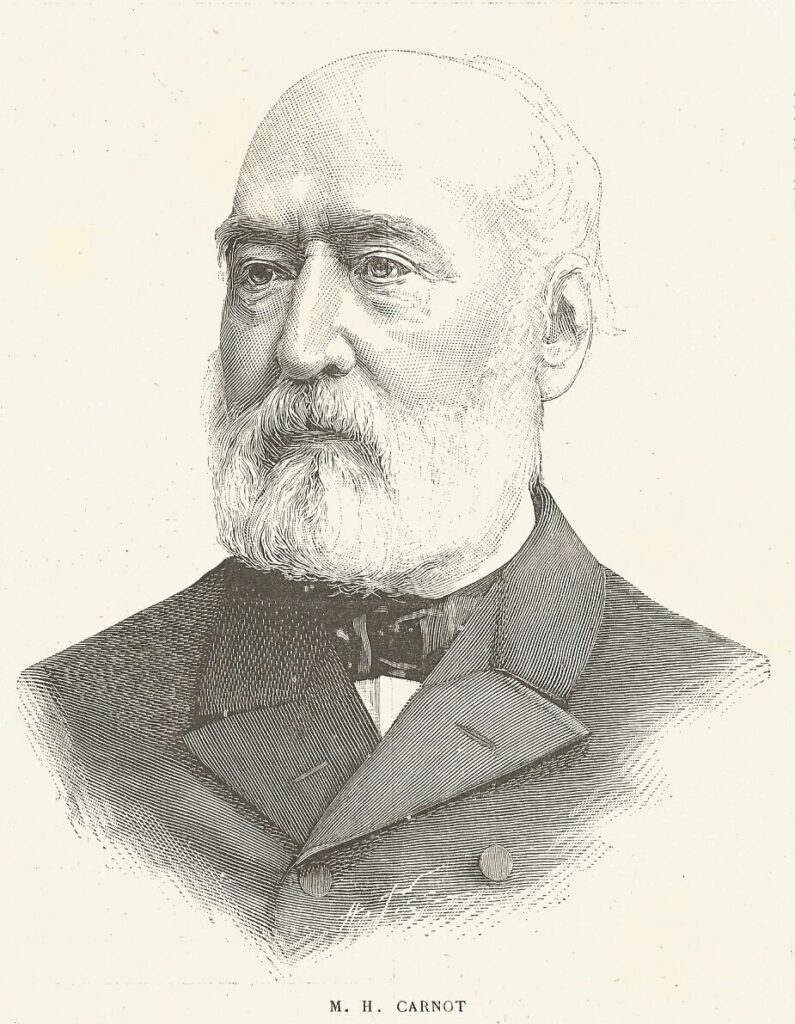
By way of conclusion, here’s the end of that of Remi Dalisson, whose magnificent biography of Hippolyte Carnot we highly recommend:
« His practice is his legislative texts on instruction, including school curricula, as varied as they are innovative, like those of his School of Administration or the ‘nursery school’. They make Carnot the undisputed precursor of Jules Ferry and the educational and civic project of the Third Republic. His laws and decrees were designed (…) to emancipate children and turn them into active, critical citizens in a peaceful, moderate and socially fluid democracy, under the aegis of restored teachers, symbols of the new times.
« His practice was his fights and commitments, first and foremost in the opposition, to which he belonged for a long time. His early writings against the death penalty, his participation in the events of 1830, his role in the 1848 Assembly, his fight for teachers, for whom he spent lavishly, and his voluntary exile are all worthy of note. (…)
« In a century crushed by the memory of two world wars, by the erasure of the Republic under Vichy and then by decolonization and the fall of Communism, forgetting 1848 and its social and educational hopes speaks volumes about our mental structures and our memory. This kind of amnesia, which does not prevent the often anachronistic sacralization of the republican corpus, has consigned Hippolyte Carnot and the whole of the 19th century to a sad oblivion. The period no longer evokes much of anything, apart from the occasional spotlight. It has even been sacrificed in teaching, as if only the 20th century were worthy of study.
« At a time when the French educational model is being called into question, when the republican school is doubting its missions, when secularism is also being discussed and when teachers feel abandoned, it is more necessary than ever to understand the roots of an educational system intimately linked to the republican regime. To this end, at the dawn of the 21st century, a reappraisal of the life and work of Hippolyte Carnot, a staunch defender of freedom, schools, Clio and the Republic, can lay the foundations for renewed, civic-minded reflection on the school system.«
19. Appendix: list of works by Hippolyte Carnot
- Gunima, an 18th-century African short story (Paris, Barba, 1824).
- Le Gymnase, a collection of morals and literature (Paris, Balzac, 1828).
- Doctrine de Saint-Simon (Brussels, Hauman, 1831).
- Mémoires de Grégoire, Évêque constitutionnel de Blois (Paris, Dupont, 6 vols., 1837-1845).
- Quelques réflexions sur la domesticité (Paris, Henry, 1838).
- Rapport sur la législation qui règle dans quelques états d’Allemagne les conditions de travail des jeunes ouvriers (Paris, Imp. Royale, 1840).
- Mémoires de Barère de Vieuzac (avec David d’Angers) (Paris, Labitte, 4 volumes, 1842-1844).
- L’Allemagne avant l’invasion française (Fragments*, Paris, Revue indépendante, 1842).
- L’Allemagne pendant la Révolution (Fragments*, Paris, Revue indépendante, 1843).
- Les Esclaves noirs (Paris, Magasin pittoresque, 1844).
- De l’esclavage colonial (Paris, Revue indépendante, 1845).
- Les Radicaux et la Charte, (Paris, Pagnerre, 1847).
- Le Ministère de l’Instruction Publique et des Cultes, 24 février-5 juillet 1848 (Paris, Pagnerre, 1848).
- Éducation républicaine, (Paris, Prost, 2 vols., 1849).
- L’insurrection littéraire en Allemagne (Fragments*, Paris, Liberté de penser, 1848).
- Le Mémorial de 1848, (Paris, Revue indépendante, n.p. 1849).
- Doctrine saint simonienne (Paris, Librairie nouvelle, 1854).
- Mémoires sur Lazare Carnot par son fils (Paris, Pagnerre, 1861-63, reed. in 1893 and 1907, Hachette).
- Œuvres de Saint-Simon by Enfantin, preceded by two historical notes by H. Carnot (Paris, Dentu, 1865).
- La Révolution française, résumé historique (2 vols., Paris, Dubuisson et Pagnerre, 1867).
- L’Instruction populaire en France (Paris, Degorce-Cadot, 1869).
- Trois discours sur l’instruction publique, (Paris, Degorce-Cadot, 1869).
- Cours de l’association philotechnique pour l’instruction gratuite des adultes (Paris, Parent, 1872).
- Ce que serait un nouvel Empire (Paris, Société du patriote, Bibliothèque utile, 1874).
- Lazare Hoche, général républicain (Paris, Société du patriote, Bibliothèque utile, 1874).
- D’une École d’Administration (Versailles, Aubert, 1878);
- Henri Grégoire, évêque républicain (Paris, Libraire des publications populaires, 1882).
- La Révolution française (Paris, Boulanger, 1888).
- Les premiers échos de la Révolution française au-delà du Rhin (Paris, Picard, 1888).
20. Short list of books and articles consulted
- Rémi Dalisson, Hippolyte Carnot, la liberté, l’école et la République, CNRS Editions, Paris 2011.
- Paul Carnot, Hippolyte Carnot et le ministère de l’Instruction publique de la IIe République, PUF, Paris, 1948.
- Jacques Cheminade, Lazare Carnot, l’organisateur de la victoire.
- Jacques Cheminade, L’exemplarité de l’oeuvre d’Henri Grégoire et de Lazare Carnot, 2005.
- Jacques Cheminade, Dino di Paoli and Claude Albert, L’Ecole polytechnique et la science de l’éducation républicaine, Campaigner publications, 1980.
- Website: Le temps des instituteurs.
- Karel Vereycken, The statue of Gutenberg in Strasbourg, the republican fight of David d’Angers.
- José Manuel Menudo, Une apologie des physiocrates par Condorcet, Dixhuitième siècle N° 46, pp 657 to 672.
- Condorcet, De l’influence de la révolution d’Amérique sur l’Europe (excerpts).
- Manuel Albertone, Condorcet, Jefferson and America.
- Dorette Huggins, John Adams and his reflections on Condorcet.
- E. -T. Hamy, Correspondance d’Alexandre de Humboldt avec François Arago, 1907, Paris.